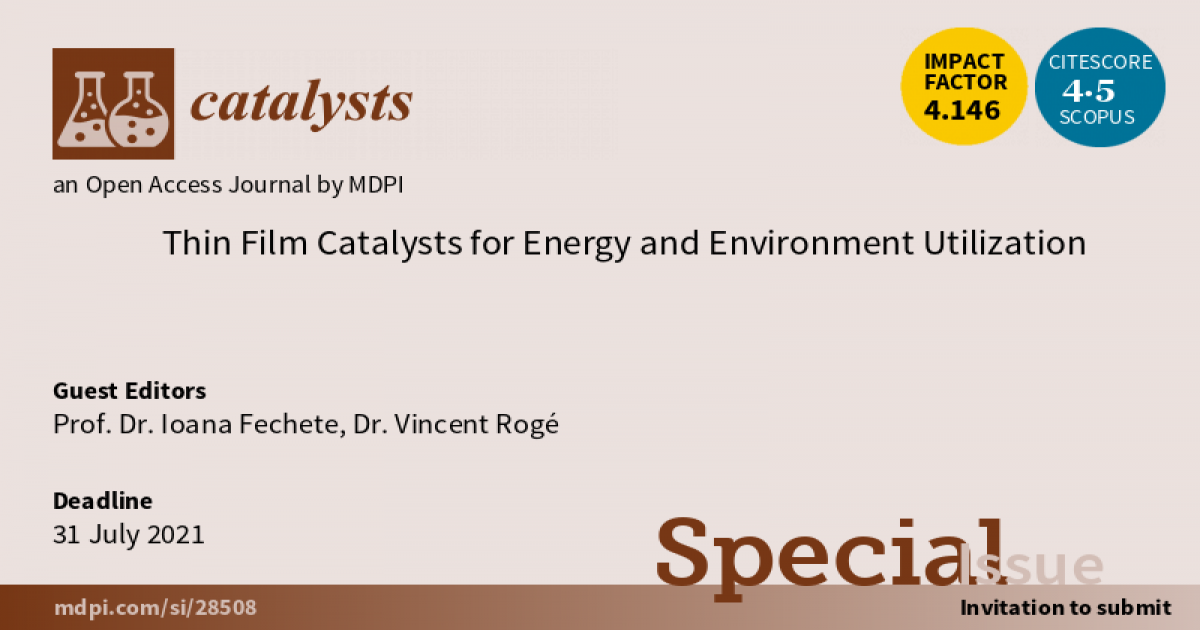Thin Film Catalysts for Energy and Environment Utilization
A special issue of Catalysts (ISSN 2073-4344).
Deadline for manuscript submissions: closed (31 July 2021) | Viewed by 23777

Special Issue Editors
Interests: environmental catalysis; electrocatalysis and fuel cells; nanostructured metal hydride composites for solid-state hydrogen storage advanced energy materials; CO2 management and utilization; H2 clean-up processes; biorefinery; biogas and natural gas management and utilization; renewable and sustainable energy; sustainable and renewable energy systems design; PEM FC; SOFC; oxygen and hydrogen evolution reaction; nanomaterials and nanotechnology; ceramic, composite, and porous materials; oxide glasses
Interests: water treatment; photocatalysis; nanotechnologies; CO2 methanation; thermoelectricity; fuel cells; water splitting; nanofilms; chemical vapour deposition; atomic layer deposition; sol-gel synthesis
Special Issue Information
Dear Colleagues,
This Special Issue is intended to cover the most recent progresses in advanced thin film materials, from the synthesis and characterization to the evaluation of catalytic activity, corrosion resistance, mechanical properties, etc.
Academic and industrial views and case studies will be given for the understanding of the thin film catalysts’ action and reaction mechanisms for the future scope and trends of the domain—in particular, the design, preparation, and characterization of thin film materials for clean energy/energy generation research and environmental applications for clean processes.
Potential topics include but are not limited to the following:
- Preparation of thin film materials/catalysts (electrocatalysts, biocatalysts, photocatalysts);
- Mechanical, electrical, and physicochemical characterization;
- Photocatalysis, plasma-catalysis, electrocatalysis, biocatalysis;
- Hydrogen production, storage, and applications;
- CO2 conversion and utilization;
- Biomass valorization and biofuel production;
- Catalytic removal of air and water pollutants;
- Catalytic elimination of solid-phase pollutants.
Prof. Dr. Ioana Fechete
Dr. Vincent Rogé
Guest Editors
Manuscript Submission Information
Manuscripts should be submitted online at www.mdpi.com by registering and logging in to this website. Once you are registered, click here to go to the submission form. Manuscripts can be submitted until the deadline. All submissions that pass pre-check are peer-reviewed. Accepted papers will be published continuously in the journal (as soon as accepted) and will be listed together on the special issue website. Research articles, review articles as well as short communications are invited. For planned papers, a title and short abstract (about 100 words) can be sent to the Editorial Office for announcement on this website.
Submitted manuscripts should not have been published previously, nor be under consideration for publication elsewhere (except conference proceedings papers). All manuscripts are thoroughly refereed through a single-blind peer-review process. A guide for authors and other relevant information for submission of manuscripts is available on the Instructions for Authors page. Catalysts is an international peer-reviewed open access monthly journal published by MDPI.
Please visit the Instructions for Authors page before submitting a manuscript. The Article Processing Charge (APC) for publication in this open access journal is 2200 CHF (Swiss Francs). Submitted papers should be well formatted and use good English. Authors may use MDPI's English editing service prior to publication or during author revisions.
Keywords
- thin film materials
- energy
- environment
- hydrogen
- CO<sub>2</sub>
- air, water, and sol pollutants
Benefits of Publishing in a Special Issue
- Ease of navigation: Grouping papers by topic helps scholars navigate broad scope journals more efficiently.
- Greater discoverability: Special Issues support the reach and impact of scientific research. Articles in Special Issues are more discoverable and cited more frequently.
- Expansion of research network: Special Issues facilitate connections among authors, fostering scientific collaborations.
- External promotion: Articles in Special Issues are often promoted through the journal's social media, increasing their visibility.
- Reprint: MDPI Books provides the opportunity to republish successful Special Issues in book format, both online and in print.
Further information on MDPI's Special Issue policies can be found here.






